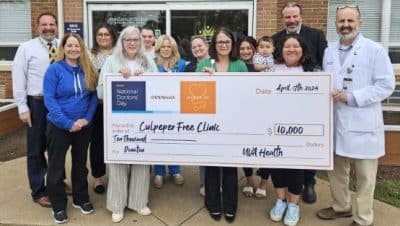The Top Story by Chris Graham
If there was a magic bullet that could be used to solve the teen-pregnancy problem, it would have been used decades ago.
But, alas, there is no magic bullet – or even a single accepted way to combat the problem.
Does traditional sex education get the job done? How about abstinence-only programs? Or efforts stressing the importance of building self-esteem?
It really is hard to say – though it isn’t difficult to get the sense that despite the fact that the hodgepodge of approaches that are currently being utilized are having something of an impact on teen-pregnancy rates overall, there is still a long, long way to go before we can declare the war on teen pregnancy a mission accomplished.
Battle lines
“The price of teen pregnancy on our society is tremendous,” said Bill Albert, a spokesman for the Washington, D.C.,-based National Campaign to Prevent Teen Pregnancy.
“It affects the economy. It affects the job sector. It affects education. We’ve known this for decades based on research on the impact of teen pregnancy,” Albert said.
“Certainly teen pregnancy is an issue of reproductive health. But it’s much more than that. If you care about issues like economic growth, education, child-rearing, teen-pregnancy prevention is important to you,” Albert told The Augusta Free Press.
That said, it is much easier to say the words than it is to accomplish anything in that regard – especially considering that an estimated three in five teens report that they are sexually active by the time that they graduate from high school, and a third of American females get pregnant by age 20.
The Regional Teen Pregnancy Prevention Coalition is out there fighting on the front lines of the pregnancy-prevention war. The coalition, which oversees prevention efforts in the Greater Augusta County area, focuses its attention on going beyond basic sex ed and working to build the self-esteem of teens.
“We’re in classrooms in all three localities here basically every day with students between fourth grade and 10th grade,” said Ginny Newman, the coordinator of the local coalition.
The program has thus been able to build a rapport with students locally over the course of the past several years, Newman said.
“The discussions that we have in classes on these issues are lively,” Newman said.
“We don’t stand up in front of classes and lecture. We try to get kids engaged, and because they feel comfortable around us, because they have been around us, in some cases, for several years, they do engage themselves,” Newman told the AFP.
Programs like the one in the Greater Augusta area that “focus less on sex and more on how our adolescents are doing emotionally” have a proven track record of success, said Joseph Allen, a University of Virginia psychology professor and teen-pregnancy expert.
This idea goes against convention, certainly – but Allen, a veteran of teen-pregnancy-prevention efforts in Charlottesville and Albemarle County, said his research indicates that programs that highlight issues involving the building of self-esteem in teens are more successful than traditional sex-ed programs.
“There’s been a battle for at least three decades over sex education. One side would say that sex education is the only way to give kids information to prevent pregnancy. Another side would say that sex education gives kids the idea of having sex and suggests that it’s an OK thing for adolescents to do and is part of the problem. That’s one area where we’ve done a lot of very good research, and the answer is really quite clear. Simple sex education, where you’re just simply presenting information, has almost no effect on teens’ behavior,” Allen told the AFP.
“Kids take about as much away from their ninth-grade sex-education course as they do from their ninth-grade world-history course section on the Middle Ages,” Allen said.
“It’s not something that they tune into or register, and even if they do register it at the time, the way I explain this to parents and teachers, if you think about a ninth-grader learning about Charlemagne in their world-history course, that’s fine, but what if you tested them six months later on a Friday night in the backseat of a car after they’ve had a couple of drinks?” Allen said.
Dr. Michael Carrera, the director of adolescent-sexuality and pregnancy-prevention programs for The Children’s Aid Society in New York, became aware of the same phenomenon two decades ago.
“For many years, I felt that I wasn’t really getting my message across in the fashion that I wanted to,” Carrera told the AFP.
“My emphasis then was principally on communicating information about sexuality and sexual expression,” Carrera said. “I didn’t feel that that message was sticking in a way that influenced the young people’s behavior. They liked what they were hearing, certainly. They gave me very good evaluations. But in life, you frequently know more than what the appearance is. And while it seemed like everybody was happy, I didn’t feel like they were carrying what I was giving them to the outside world.”
So Carrera decided to go to the real experts in what teens needed to hear regarding sexuality and pregnancy issues.
“If you talk to people who are teens about the kind of programs they like, they’ll tell you what you need to know,” Carrera said. “Some wanted to do better in school. Some wanted a job, wanted money in their pocket. Some were interested in the arts. Some were interested in sports. Some wanted to be able to talk to someone privately and confide in someone. And some were interested in sex.
“There were six things that continually came up when I spoke to young people about what they liked,” said Carrera, who added a seventh element to his program, involving the importance of finding family doctors and dentists to provide medical care in the stead of relying on emergency rooms.
“When you’re dealing with arts and sports and counseling and having a doctor and a dentist and jobs and homework help and tutoring and sex ed, that really constituted an above-the-waist approach where six-sevenths of the program had very little to do with sexuality and sexual expression,” Carrera said.
The lesson was an important one for Carrera and others in the prevention field to pick up.
“Providing sexuality information even in the most comprehensive way was not the strategy to reduce pregnancy,” Carrera said. “Comprehensive sexuality education is a must. It influences sexual literacy, and if you do it in an age- and stage-appropriate way, that really has to do with what a person who is an informed individual in our society has to understand at any point in their life, just in the same way that we have a sort of pacing calendar for teaching mathematics, for social studies. You lead up to things.
“But the provision of sexuality education is not the way to reduce teen pregnancy. The way to reduce teen pregnancy is to provide young people with what they need to know about sexuality, provide them with services in the event that they need them, but to work with all the other things that make them whole people. That’s what gets the message to stick,” Carrera said.
Mary Sullivan, the coordinator of the teen-pregnancy prevention program operated by the Charlottesville/Albemarle Commission on Children and Families, favors a similar kind of approach.
“You do as much as you can to support those kids who are postponing sexual activity, because the longer they postpone sexual activity, the less likely they are to have to deal with an unintended pregnancy or sexually transmitted infection. An abstinence message is always a part of a comprehensive sexuality-education program. It should always be a part of that,” Sullivan told the AFP.
“But while I believe that abstinence is a key part of a sexuality-education program, I’m not in favor of, nor have they been deemed to be effective, the abstinence-only education programs that have been heavily promoted and financed over the last five years,” Sullivan said.
“We’re spending millions of dollars at the national, state and local levels on abstinence programs, and if they had been rigorously evaluated to be effective, I would say right on,” Sullivan said.
“But we also have to be realistic about the large number of teen-agers who are already sexually active, and we have to help them prevent an unintended pregnancy or sexually transmitted infection,” Sullivan said.
Winning the war
The good news is that it appears that those prevention efforts are working, by and large. But that is the “glass half full” part of the story, Albert said.
“The glass half empty is that despite the improvements that we have made in the past decade, the U.S. still ranks well behind comparable countries in terms of the rate of teen pregnancy here,” Albert said.
The problem with this, Albert said, is that the word that has spread regarding the improvements that have been made could serve to limit future progress in combating teen pregnancy.
“We’ve seen this happen in communities everywhere where significant strides have been made, and there is almost a sense that develops that we’ve solved this problem, so let’s move on to something else,” Albert said.
Carrera notes a concern on that point as well.
“Once something seems to start to turn downward, Americans want to look at other issues to try to pour resources in them,” Carrera said.
“My view is now that we have this downturn in adolescent pregnancy rates, we should do a full-court press on it so that we get it down to rates that are the equal of other industrialized countries in the world,” Carrera said.
(Originally published 01-30-06)










